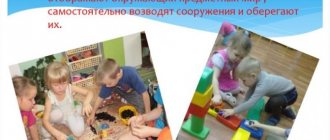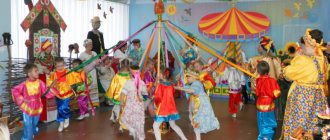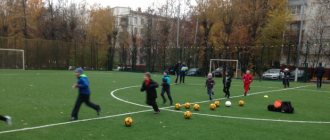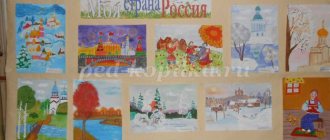BUILDING AND CONSTRUCTION GAMES FOR PRESCHOOL CHILDREN
Construction and construction games are a type of creative play and are considered as children’s activities, the main content of which is the reflection of the surrounding life in various buildings and related actions. In construction-constructive games, some objects are replaced by others: buildings are erected from specially created building materials and constructors, or from natural materials. Games are often closely intertwined with a role-playing game and can be its beginning. Sometimes the building is not used in the game, but is part of its setting; it can take place in the form of a role-playing game, for example, in the game there is the role of a builder, a driver delivering goods to a construction site, etc. But there are construction games in which all content is limited to the construction of buildings and structures.
In the process of this type of game, children form and develop orientation in space, the ability to distinguish and establish the size and proportions of an object, children comprehend the simplest laws of physics. Construction game accustoms children to purposeful, systematic activity, thinking develops, and an accurate vocabulary is formed that expresses the name of geometric bodies and spatial relationships. The problems of moral education are also solved - children become familiar with the work of builders, help each other, and try to create beautiful buildings together.
In the history of pedagogy, games with building materials are represented in many systems: F. Froebel, M. Montessori, L. Schleger. In domestic pedagogy, this issue was studied by V. G. Nechaeva, 3, V. Lishtvan, A. N. Davidchuk, L. A. Paramonova and others.
The peculiarity of games with building materials is that special training is necessary to master constructive skills. In preschool pedagogy, a methodology for developing constructive skills in children has been developed (E.A. Flerina, Z.V. Lishtvan, etc.). At the same time, construction games are creative games, since they are characterized by independence, self-organization, creativity and emotional richness. Based on the characteristics of this type of game, the teacher in its management faces a number of tasks:
1. Expanding children’s understanding and directing their attention to the work of builders and the equipment they use.
2. Training in construction methods, education and development of independence, active thinking, constructive and creative abilities.
3. Formation of hard work, development of correct relationships among children, uniting them into a friendly team.
In the younger groups of kindergarten, children develop simple but clear building and constructive skills. The guidance consists of creating a play environment, selecting and providing children with building materials, arranging toys, and playing with buildings. The teacher suggests the idea of the work and is an active participant in the game.
In the middle group, children’s interest in building games is further developed, the contents of buildings are used in role-playing games, and the ability to build not only according to a model, but also according to a theme outlined by the children themselves. The teacher shows techniques for constructing more complex additions, teaches how to choose a topic, and determine the sequence of construction of the building. Management should ensure that children’s impressions of the surrounding reality are enriched, training in construction techniques through the use of a model, in the process of joint construction with the teacher. The teacher also offers independent choice of both the themes of the buildings and the plots of the games.
In older preschool age, collective games are expanded, children are taught to plan them in advance, set the goal of the game, determine the participants by prior agreement, and use constructive and construction skills not only using a visual model, but also from drawings and photographs of various structures. The teacher teaches how to think about game actions, compare, and implement decisions. The word takes on great importance; the source of the construction can be the story of an adult.
Playing with natural materials occupies a special place in a child’s life. Children build with snow and sand and play with water. These games contain great opportunities for the development of the child, but, as teachers note, without special development they can be monotonous and have little content.
Construction games require special attention in organizing the gaming environment. The teacher needs to select building materials that correspond to the tasks of developing the constructive activity of children of this age. The material should be varied: floor, tabletop, different types of construction sets, sets, etc.; attractively designed, stable enough to suit the capabilities of children.
Consultation for parents “The influence of playing with building materials on the development of a child”
Potapova Elena Anatolyevna
Consultation for parents “The influence of playing with building materials on the development of a child”
Preschool childhood is a short but very important period in the development of a child’s personality.
It is during these years that the child acquires initial knowledge about the life around him, his character develops, skills and habits of correct behavior are developed, and a certain attitude towards people and work begins to form.
As you know, the main activity of preschool children is play. In the process, the games develop - the spiritual and physical qualities of the child.
And games with building materials
promote: mental and sensory development of children.
By working with it, children learn the shape, color of objects, their size, acquire elementary spatial concepts, and provide an opportunity for the development of the creative side of the intellect.
These games don’t get boring for a long time, as they have great variety, variety of combinations, and help the child’s creative self-expression.
In the process of playing with building materials, children learn to name in one word the characteristics of objects with which they are already familiar, children’s speech develops, and their vocabulary expands.
As in any activity, there are children for whom construction comes very easily, that is, they really like to make various buildings - they already have the perseverance necessary for this, and the ability to see a generalized image, and not individual details.
But there are also children who need your help in creating any building.
For the development of such games, appropriate conditions are necessary. The most important of them is teaching simple constructive skills.
Taking this into account, you can organize such games - activities at home, where each participant performs his own task.
We recommend that you organize such games with your child, as children love joint activities, especially with dad and mom.
Those who say that children don’t like to build are wrong. Children just need to be shown how to do it correctly. Sit with the children, show that you are interested in this, and together add objects to the game.
To do this, purchase the necessary building material.
A wide selection of construction sets in our stores gives you, dear parents, the opportunity to purchase exactly the one that will interest your child.
Recommendations for parents:
— Parents should remember the first impression of the game. How you present a new game is very important;
— When playing with building materials, make sure that children finish what they start;
- Avoid very detailed and suggestive explanations and demonstrations during construction;
- If you see that something is not working out for a child, and the desire to build disappears, help him - tell him what needs to be done to complete the building;
— When playing games with building materials, it is unacceptable to change the sequence of the game at your own discretion;
- Upon completion of the construction, ask the child what parts the building was made of, how many bricks were needed, etc.;
- Play around with the building and praise the child.
Conclusion: Playing with building materials and various construction sets will help your child develop:
- fine motor skills;
- spatial orientation - an idea of the location of objects in space and relative to each other;
- imagination;
- Creative skills;
- learn a lot of new things;
— improve basic technical skills;
— activate the dictionary.
The main ways to implement the management of construction games for preschoolers
Construction games and their optimal organization are necessary for the development of preschoolers. They are focused on the educational development of children, on developing their constructive skills. The effect of their educational influence is directly related to the rational organization of leadership, the use of optimal techniques and methods of educational influence.
Figure 1. Construction games. Author24 – online document exchange for students
In order to teach children specific construction skills and abilities, to develop in their minds a certain concept of design work, it is necessary to regularly familiarize children with the methods of construction of various buildings, the characteristics of materials and their functional purpose. This leads to a gradual expansion of the child’s knowledge, which, in turn, makes construction games more meaningful, develops the ability to build more complex structures and improves construction techniques.
Too lazy to read?
specialists and get an answer in 15 minutes!
Ask a question
Figure 2. Characteristics of construction games. Author24 – online document exchange for students
Construction game management is focused on solving the following educational tasks:
- Formation and development in children of ideas about the importance of work, the need to develop labor skills, especially in the construction industry, focusing children’s attention on the organization of work of builders, instilling respect for this field of activity, the desire to preserve the original appearance of the building, the need to treat it with care and respect it ;
- Familiarization with various construction methods. This allows you to develop the child’s creative and constructive abilities, activates his intellectual activity, develops thought processes;
- Teaching hard work, respect for work, developing teamwork skills and methods of collective interaction.
Too lazy to read?
specialists and get an answer in 15 minutes!
Ask a question
Observation 1
By supervising construction games, the teacher creates an optimal play space that allows organizing construction work, selecting the necessary material in sufficient quantity so that all children can participate in the game.
Providing the possibility of real observation of the construction of any object is important for the competent organization of management of the construction game process. To do this, the teacher can bring illustrations of the various stages of construction work, show films on construction topics, prepare a presentation, or organize an excursion to the construction site. This will enrich children's ideas of construction, which will have a beneficial effect on the development of the game plot.
In addition, familiarity with construction based on the use of special builders is of no small importance. Children know the design details of various shapes and modifications: cubes, bricks, plates, cylinders. The teacher, in turn, shows ways to connect them and design options. Having mastered the possibilities of working with the designer, the child begins to fantasize and develop new modifications.
Construction games are held in two main areas:
- Familiarization with constructive activities in specially organized classes.
- Demonstration of construction techniques and development of the basic skills necessary for successful construction are carried out in the independent play of children.
In special construction classes, children learn to build various structures and expand the construction theme. Construction begins with individual small parts and objects and gradually moves on to the construction of larger buildings and structures. In the process of learning to design, children develop the ability to plan their work, predicting the results, based on the materials used for design and methods for modifying them. This has a beneficial effect on the development of the child’s thought processes, the formation of his intellectual abilities, the development of creative abilities and creative talents.






